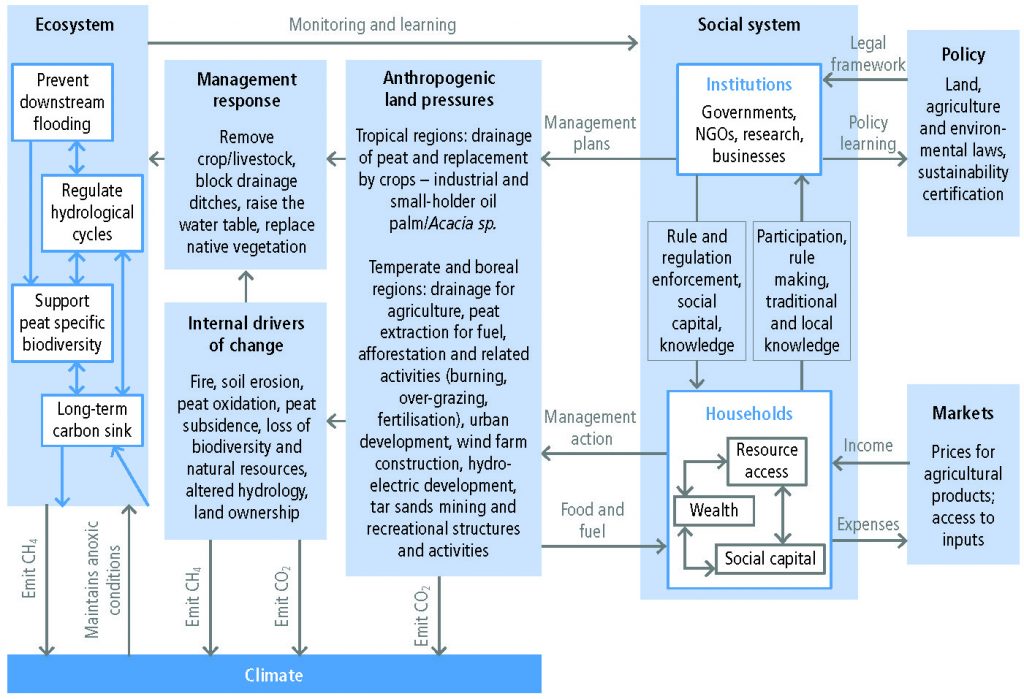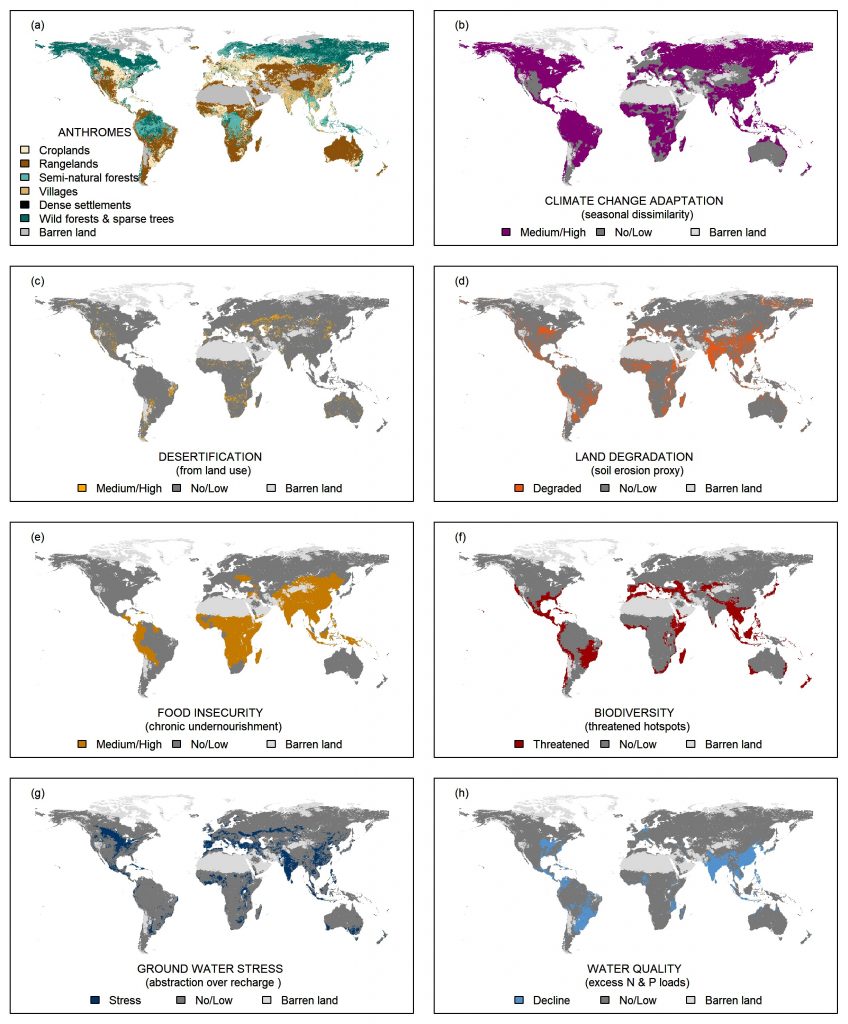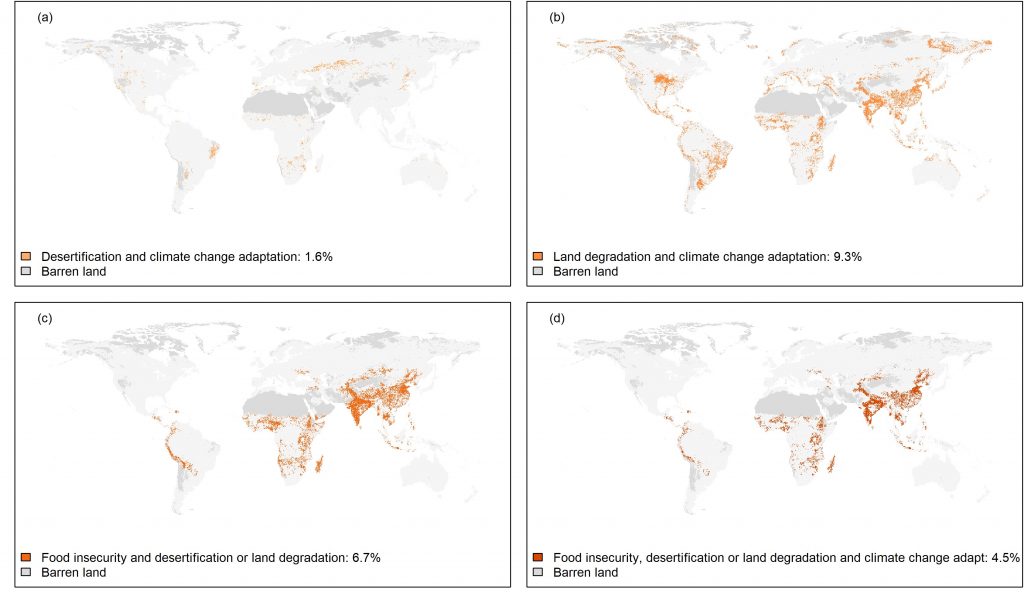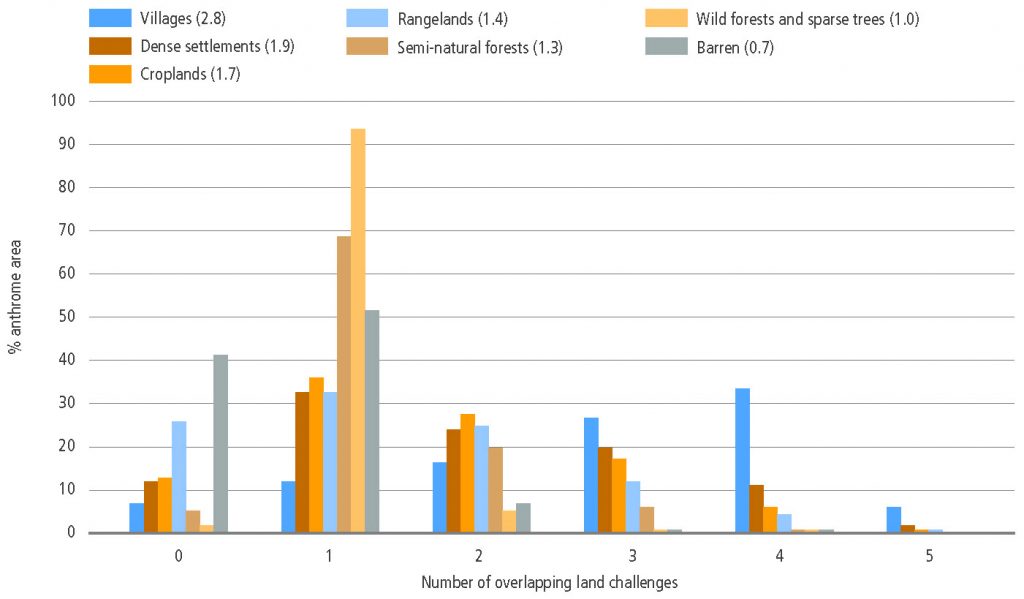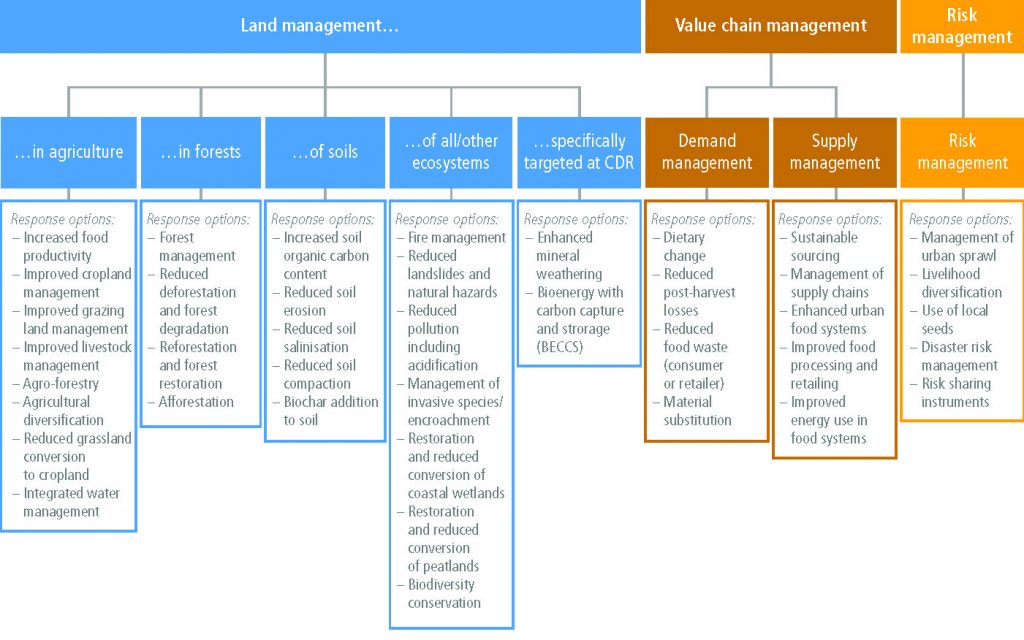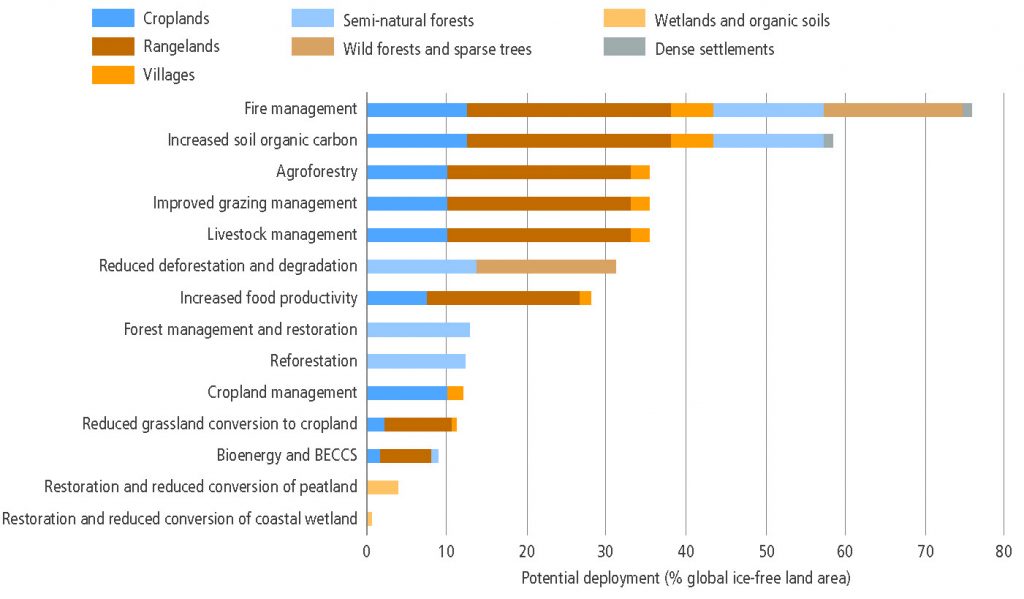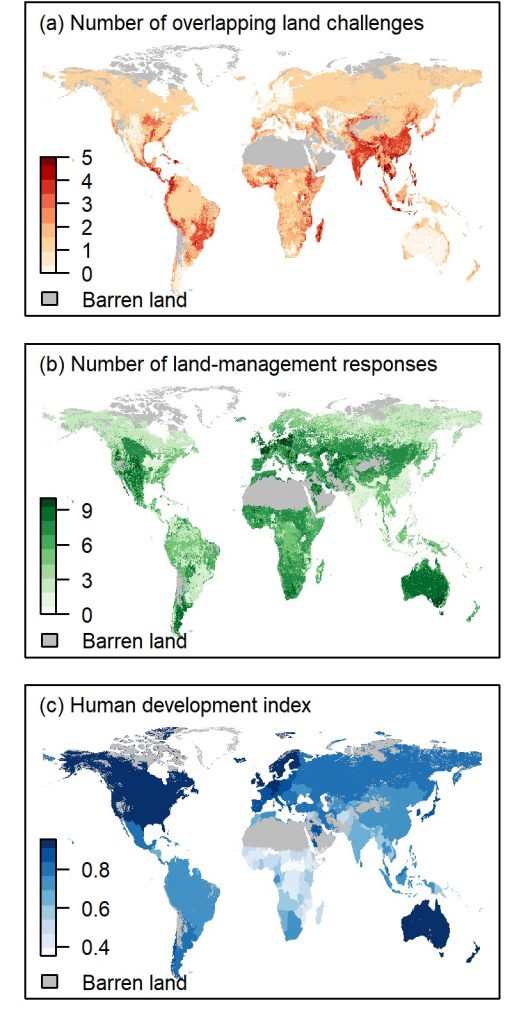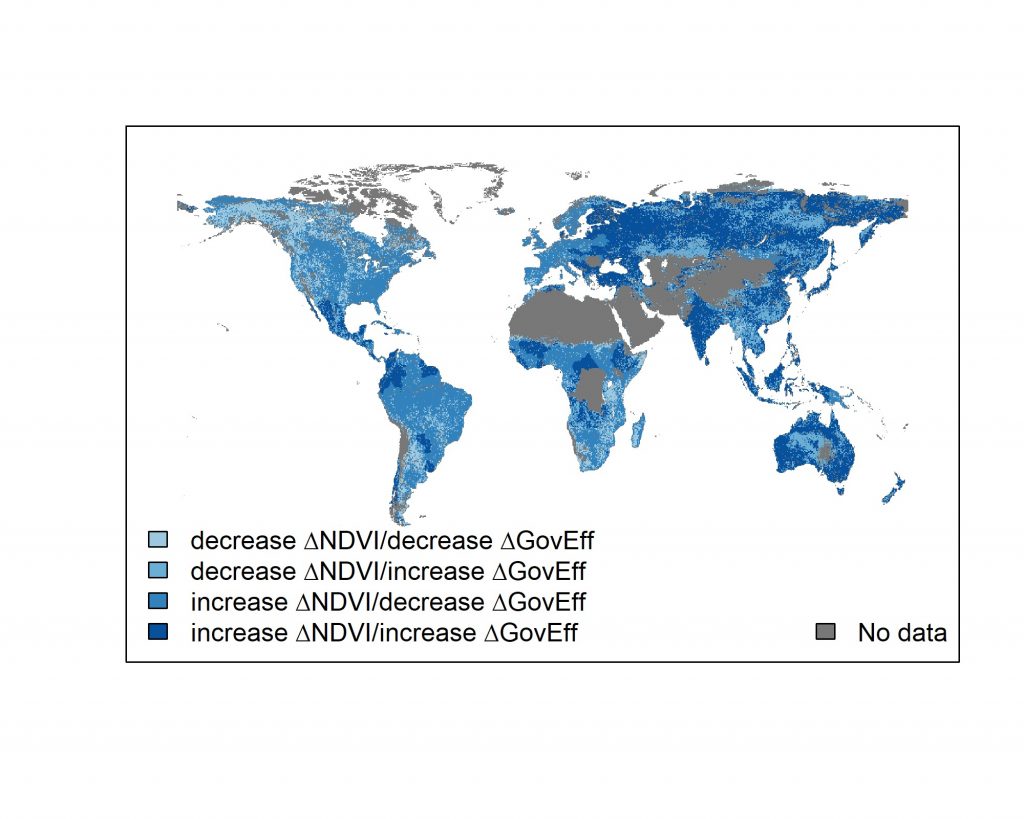ES
Executive Summary
The land challenges, in the context of this report, are climate change mitigation, adaptation, desertification, land degradation, and food security. The chapter also discusses implications for Nature’s Contributions to People (NCP), including biodiversity and water, and sustainable development, by assessing intersections with the Sustainable Development Goals (SDGs). The chapter assesses response options that could be used to address these challenges. These response options were derived from the previous chapters and fall into three broad categories: land management, value chain, and risk management.
The land challenges faced today vary across regions; climate change will increase challenges in the future, while socio- economic development could either increase or decrease challenges (high confidence). Increases in biophysical impacts from climate change can worsen desertification, land degradation, and food insecurity (high confidence). Additional pressures from socio- economic development could further exacerbate these challenges; however, the effects are scenario dependent. Scenarios with increases in income and reduced pressures on land can lead to reductions in food insecurity; however, all assessed scenarios result in increases in water demand and water scarcity (medium confidence). {6.1}
The applicability and efficacy of response options are region and context specific; while many value chain and risk management options are potentially broadly applicable, many land management options are applicable on less than 50% of the ice-free land surface (high confidence). Response options are limited by land type, bioclimatic region, or local food system context (high confidence). Some response options produce adverse side effects only in certain regions or contexts; for example, response options that use freshwater may have no adverse side effects in regions where water is plentiful, but large adverse side effects in regions where water is scarce (high confidence). Response options with biophysical climate effects (e.g., afforestation, reforestation) may have different effects on local climate, depending on where they are implemented (medium confidence). Regions with more challenges have fewer response options available for implementation (medium confidence). {6.1, 6.2, 6.3, 6.4}
Nine options deliver medium-to-large benefits for all five land challenges (high confidence). The options with medium-to-large benefits for all challenges are increased food productivity, improved cropland management, improved grazing land management, improved livestock management, agroforestry, forest management, increased soil organic carbon content, fire management and reduced post-harvest losses. A further two options, dietary change and reduced food waste, have no global estimates for adaptation but have medium- to-large benefits for all other challenges (high confidence). {6.3, 6.4}
Five options have large mitigation potential (>3 GtCO2e yr–1) without adverse impacts on the other challenges (high confidence). These are: increased food productivity; reduced deforestation and forest degradation; increased soil organic carbon content; fire management; and reduced post-harvest losses.
Two further options with large mitigation potential, dietary change and reduced food waste, have no global estimates for adaptation but show no negative impacts across the other challenges. Five options: improved cropland management; improved grazing land managements; agroforestry; integrated water management; and forest management, have moderate mitigation potential, with no adverse impacts on the other challenges (high confidence). {6.3.6}
Sixteen response options have large adaptation potential (more than 25 million people benefit), without adverse side effects on other land challenges (high confidence). These are increased food productivity, improved cropland management, agroforestry, agricultural diversification, forest management, increased soil organic carbon content, reduced landslides and natural hazards, restoration and reduced conversion of coastal wetlands, reduced post-harvest losses, sustainable sourcing, management of supply chains, improved food processing and retailing, improved energy use in food systems, livelihood diversification, use of local seeds, and disaster risk management (high confidence). Some options (such as enhanced urban food systems or management of urban sprawl) may not provide large global benefits but may have significant positive local effects without adverse effects (high confidence). {6.3, 6.4}
Seventeen of 40 options deliver co-benefits or no adverse side effects for the full range of NCPs and SDGs; only three options (afforestation, bioenergy and bioenergy with carbon capture and storage (BECCS), and some types of risk sharing instruments, such as insurance) have potentially adverse side effects for five or more NCPs or SDGs (medium confidence). The 17 options with co-benefits and no adverse side effects include most agriculture- and soil-based land management options, many ecosystem-based land management options, forest management, reduced post-harvest losses, sustainable sourcing, improved energy use in food systems, and livelihood diversification (medium confidence). Some of the synergies between response options and SDGs include positive poverty eradication impacts from activities like improved water management or improved management of supply chains. Examples of synergies between response options and NCPs include positive impacts on habitat maintenance from activities like invasive species management and agricultural diversification. However, many of these synergies are not automatic, and are dependent on well-implemented activities requiring institutional and enabling conditions for success. {6.4}
Most response options can be applied without competing for available land; however, seven options result in competition for land (medium confidence). A large number of response options do not require dedicated land, including several land management options, all value chain options, and all risk management options. Four options could greatly increase competition for land if applied at scale: afforestation, reforestation, and land used to provide feedstock for BECCS or biochar, with three further options: reduced grassland conversion to croplands, restoration and reduced conversion of peat lands and restoration, and reduced conversion of coastal wetlands having smaller or variable impacts on competition for land. Other options such as reduced deforestation and forest degradation, restrict land conversion for other options and uses. Expansion of the current area of managed land into natural ecosystems could have negative consequences for other land challenges, lead to the loss of biodiversity, and adversely affect a range of NCPs (high confidence). {6.3.6, 6.4}
Some options, such as bioenergy and BECCS, are scale dependent. The climate change mitigation potential for bioenergy and BECCS is large (up to 11 GtCO2 yr–1); however, the effects of bioenergy production on land degradation, food insecurity, water scarcity, greenhouse gas (GHG) emissions, and other environmental goals are scale- and context-specific (high confidence). These effects depend on the scale of deployment, initial land use, land type, bioenergy feedstock, initial carbon stocks, climatic region and management regime (high confidence). Large areas of monoculture bioenergy crops that displace other land uses can result in land competition, with adverse effects for food production, food consumption, and thus food security, as well as adverse effects for land degradation, biodiversity, and water scarcity (medium confidence). However, integration of bioenergy into sustainably managed agricultural landscapes can ameliorate these challenges (medium confidence). {6.2, 6.3, 6.4, Cross-Chapter Box 7 in this chapter}
Response options are interlinked; some options (e.g., land sparing and sustainable land management options) can enhance the co-benefits or increase the potential for other options (medium confidence). Some response options can be more effective when applied together (medium confidence); for example, dietary change and waste reduction expand the potential to apply other options by freeing as much as 5.8 Mkm2 (0.8–2.4 Mkm2 for dietary change; about 2 Mkm2 for reduced post-harvest losses, and 1.4 Mkm2 for reduced food waste) of land (low confidence). Integrated water management and increased soil organic carbon can increase food productivity in some circumstances. {6.4}
Other response options (e.g., options that require land) may conflict; as a result, the potentials for response options are not all additive, and a total potential from the land is currently unknown (high confidence). Combining some sets of options (e.g., those that compete for land) may mean that maximum potentials cannot be realised, for example, reforestation, afforestation, and bioenergy and BECCS, all compete for the same finite land resource so the combined potential is much lower than the sum of potentials of each individual option, calculated in the absence of alternative uses of the land (high confidence). Given the interlinkages among response options and that mitigation potentials for individual options assume that they are applied to all suitable land, the total mitigation potential is much lower than the sum of the mitigation potential of the individual response options (high confidence). {6.4}
The feasibility of response options, including those with multiple co-benefits, is limited due to economic, technological, institutional, socio-cultural, environmental and geophysical barriers (high confidence). A number of response options (e.g., most agriculture-based land management options, forest management, reforestation and restoration) have already been implemented widely to date (high confidence). There is robust evidence that many other response options can deliver co-benefits across the range of land challenges, yet these are not being implemented. This limited application is evidence that multiple barriers to implementation of response options exist (high confidence). {6.3, 6.4}
Coordinated action is required across a range of actors, including business, producers, consumers, land managers, indigenous peoples and local communities and policymakers to create enabling conditions for adoption of response options (high confidence). The response options assessed face a variety of barriers to implementation (economic, technological, institutional, socio-cultural, environmental and geophysical) that require action across multiple actors to overcome (high confidence). There are a variety of response options available at different scales that could form portfolios of measures applied by different stakeholders – from farm to international scales. For example, agricultural diversification and use of local seeds by smallholders can be particularly useful poverty eradication and biodiversity conservation measures, but are only successful when higher scales, such as national and international markets and supply chains, also value these goods in trade regimes, and consumers see the benefits of purchasing these goods. However, the land and food sectors face particular challenges of institutional fragmentation, and often suffer from a lack of engagement between stakeholders at different scales (medium confidence). {6.3, 6.4}
Delayed action will result in an increased need for response to land challenges and a decreased potential for land-based response options due to climate change and other pressures (high confidence). For example, failure to mitigate climate change will increase requirements for adaptation and may reduce the efficacy of future land-based mitigation options (high confidence). The potential for some land management options decreases as climate change increases; for example, climate alters the sink capacity for soil and vegetation carbon sequestration, reducing the potential for increased soil organic carbon (high confidence). Other options (e.g., reduced deforestation and forest degradation) prevent further detrimental effects to the land surface; delaying these options could lead to increased deforestation, conversion, or degradation, serving as increased sources of GHGs and having concomitant negative impacts on NCPs (medium confidence). Carbon dioxide removal (CDR) options – such as reforestation, afforestation, bioenergy and BECCS – are used to compensate for unavoidable emissions in other sectors; delayed action will result in larger and more rapid deployment later (high confidence). Some response options will not be possible if action is delayed too long; for example, peatland restoration might not be possible after certain thresholds of degradation have been exceeded, meaning that peatlands could not be restored in certain locations (medium confidence). {6.2, 6.3, 6.4}
Early action, however, has challenges including technological readiness, upscaling, and institutional barriers (high confidence). Some of the response options have technological barriers that may limit their wide-scale application in the near term (high confidence). Some response options, for example, BECCS, have only been implemented at small-scale demonstration facilities; challenges exist with upscaling these options to the levels discussed in this Chapter (medium confidence). Economic and institutional barriers, including governance, financial incentives and financial resources, limit the near-term adoption of many response options, and ‘policy lags’, by which implementation is delayed by the slowness of the policy implementation cycle, are significant across many options (medium confidence). Even some actions that initially seemed like ‘easy wins’ have been challenging to implement, with stalled policies for reducing emissions from deforestation and forest degradation and fostering conservation (REDD+) providing clear examples of how response options need sufficient funding, institutional support, local buy-in, and clear metrics for success, among other necessary enabling conditions. {6.2, 6.4}
Some response options reduce the consequences of land challenges, but do not address underlying drivers (high confidence). For example, management of urban sprawl can help reduce the environmental impact of urban systems; however, such management does not address the socio-economic and demographic changes driving the expansion of urban areas. By failing to address the underlying drivers, there is a potential for the challenge to re-emerge in the future (high confidence). {6.4}
Many response options have been practised in many regions for many years; however, there is limited knowledge of the efficacy and broader implications of other response options (high confidence). For the response options with a large evidence base and ample experience, further implementation and upscaling would carry little risk of adverse side effects (high confidence). However, for other options, the risks are larger as the knowledge gaps are greater; for example, uncertainty in the economic and social aspects of many land response options hampers the ability to predict their effects (medium confidence). Furthermore, Integrated Assessment Models, like those used to develop the pathways in the IPCC Special Report on Global Warming of 1.5°C (SR15), omit many of these response options and do not assess implications for all land challenges (high confidence). {6.4}
